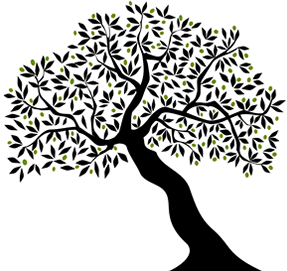The Bible is a book of both concrete truth and creative metaphors. God is gentle, and God is a rock. Jesus was born of the virgin Mary, and Jesus is living water. Humans are selfish creatures, and humans are branches. Yahweh is faithful, and Yahweh is a shepherd. God is divine, and God is a king. And metaphor within metaphor — God’s Kingdom has arrived, and it is a mustard seed.
As words, metaphors give shape to non-concrete realities. As images, metaphors invite us to see, discover, understand and experience the embodied truth.
One of the most commonly mentioned things in the Bible is also one of its most powerful theological metaphors — trees. (Check out this article for more thoughts on trees in Scripture.)
God’s expansive story begins with all kinds of beautiful trees, and also two very specific trees (Genesis 2:17; 3:22). It ends with two healing trees of life flanking a river of living water (Revelation 22:1-2). Within the story, both God’s people and God Himself are described as trees (Psalm 52:8; Hosea 14:8). Wisdom is a tree of life (Proverbs 3:18). Isaiah tells trees to sing and clap their hands. Those who love, fear, and hope in Yahweh are trees planted by a riverbank (Psalm 1, Jeremiah 17). Those who love, trust and follow Jesus are deeply rooted in Him (Colossians 2:6-7).
Deep roots, strong trunks, healthy branches, flourishing fruit, and sometimes beautiful flowers are concrete earthly realities that reflect profound spiritual truth.
As part of the Deeper initiative, we’ve created a visual metaphor of discipleship intended to foster deep dialogue and encourage focused intentionality. At the same time, it will also help each of us:
Carefully contemplate what it means to follow Jesus in both general and specific ways.
Honestly reflect on our own personal lives of discipleship.
Prayerfully consider our discipleship hopes and desires for those in our ministries.
You can find a downloadable PDF of the image here.
Leadership 1, Modules 11 and 12 (in YL Access) offer some thoughts on how to engage with this image (and other new discipleship tools) both individually, among your leadership team, and with those in your ministry.
Here are some reflection questions and dialogue prompts to get you started:
How do the three main tree elements relate and work together?
Roots — “time in Scripture, time in prayer,” more.
Trunk — a strong core of love, trust and more.
Branches — expressions or displays of specific behaviors and attitudes repeatedly highlighted throughout Scripture.
In your current season of life, how do you engage in, experience or express each of the different elements in the tree?
What specific areas (within trunk, core, branches) of your personal discipleship are most in need of attention, guidance or challenge?
How can you lean into those things intentionally and purposefully?
What specific areas of your personal discipleship (within trunk, core, branches) do you naturally embrace and dig into? Why? What does that look like?
Think about your specific ministry focus (WyldLife, Young Life, YoungLives, Young Life Capernaum, Young Life College) and your specific ministry context (community size, location, primary culture, specific subcultures, socio-economics). Based on those realities, what are your hopes and desires for your students’ growing life of discipleship? For example, what do you hope “time in Scripture” will begin to look like for those in your small group of teen moms? Or how do you hope your seventh-grade WyldLife Campaigners guys will begin to display “faithful witness”? And so on.
How will you intentionally disciple your students with these things in mind?
Written By: Crystal Kirgiss, V.P. of Discipleship (crystal.kirgiss@comcast.net)

